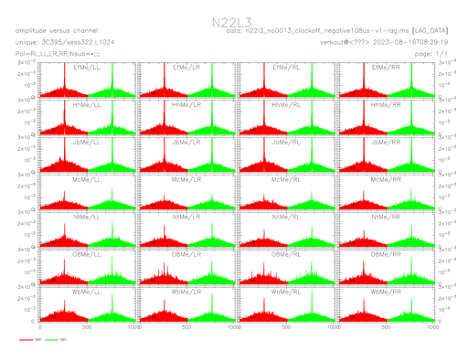
VLBI fringes demonstrated with phased-up MeerKAT
by: Marcel Gouws (SARAO, South Africa) and Marjolein Verkouter (JIVE, The Netherlands)
MeerKAT is an SKA precursor telescope consisting of 64 dishes distributed across 8 kilometers within the Northern Cape region of South Africa. MeerKAT has accumulated an impressive scientific output since its inauguration in 2018, and adding the capability to operate it as a VLBI station has remained a long-standing goal.
Initial steps were taken in 2018, when fringes were demonstrated between EVN telescopes and ADC samples captured from a single MeerKAT dish in vertical polarisation (https://www.jive.eu/jivewiki/lib/exe/fetch.php?media=evnnews:evn_newsletter51.pdf). Recent work made progress on development of a dedicated Digital Signal Processing chain for MeerKAT’s VLBI mode. A selected 107 MHz section of MeerKAT’s L-band (900 – 1670 MHz) is channelised to enable coherent beamforming using all 64 dishes. The beamforming output signal is stored and reprocessed offline to extract the desired VLBI channels. Offline reprocessing transforms the phased-up beam’s complex, frequency-channelised signal into several real-valued baseband signals, one per desired VLBI channel, in VDIF format. The present intent is to extract two 32 MHz VLBI channels per polarisation.
In order to test the developed DSP algorithms, MeerKAT co-observed with the EVN in Scan 13 of the third L-band Network Monitoring Experiment in 2022 (N22L3), a scan on the strong calibrator 3C395. The EVN recorded data at 1 Gbps (128 MHz / polarisation), sampling sky frequencies from 1594.49 - 1722.49 MHz. Ten seconds of data of the two 32 MHz upper and lower sidebands around 1626.49 in Horizontal and Vertical polarisation were extracted from the 107 MHz MeerKAT band and reformatted to two-bit real-sampled VDIF at 64 Msamples/second. JIVE staff downloaded the data and correlated it with the rest of the EVN stations, successfully finding fringes as shown in the figure below:

The success of this demonstration provides the needed confidence to proceed with the next stages of development. Notably, the execution speed of offline reprocessing routines needs to be increased. These are currently too slow for operational use, as they were intended for short verification tests of the signal processing chain to the VLBI correlator. Additional priorities include establishing station calibration procedures, as well as converting MeerKAT’s output from linear to circular polarisation.
The addition of the phased-up MeerKAT array to a VLBI network has been a part of the design from an early stage, at least dating back to testing with the KAT-7 prototype array. Phasing up MeerKAT’s 64 individual dishes into a single-pixel element provides a very sensitive element in the southern hemisphere. Any VLBI array with overlapping observing frequency and source visibility will benefit from the long, sensitive, baselines for calibration and imaging purposes.
This proof-of-concept comes at a time when the upgraded GMRT is going through exactly the same technological roadmap of phasing-up the array in a correlator/beamformer and offline generation of a VLBI-compatible data stream. The overlap in available observing frequency between MeerKAT (900 – 1670 MHz) and uGMRT (1000 – 1460 MHz) opens possibilities for eventually having two sensitive elements in 21-cm VLBI observations.